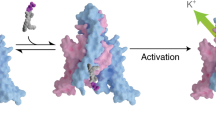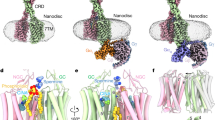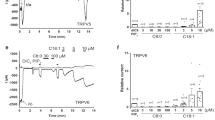Abstract
There has recently been renewed interest in a previously observed phenomenon1 whereby hormones and neurotransmitters alter the rate of incorporation of 32P-phosphate into phospholipids, specifically, phosphatidylinositol (PI) and phosphatidic acid (PA)2. This has arisen from a theory formulated by Michell and coworkers which postulates that this ‘phospholipid effect’ is in some way intimately involved in the mechanism by which certain neurotransmitters and hormones activate membrane Ca gates2–5. However, although Michell's observations are consistent with a phospholipid involvement probably somewhere between receptor occupation and Ca gating, they do not suggest what the specific role of the phospholipids in the Ca gating mechanism might be. Recently, Salmon and Honeyman suggested6 that the critical event may be the net formation of PA following the net breakdown of PI which occurs in pancreas7, platelets8 and smooth muscle6,9. PA has been shown to behave as a Ca ionophore in a Pressman chamber10, and thus it is possible that an increase in PA concentration in cellular membranes might increase the Ca permeability of those membranes (see also ref. 5). In the rat parotid, receptors associated with Ca gating (muscarinic, α-adrenergic and substance P) show a phospholipid effect whereas β-adrenergic receptors (which act on adenylate cyclase) do not11,12. The phospholipid effect is Ca independent, and is not produced by the divalent cationophore A23187 (refs 11,12). Also, an easily quantifiable response of this tissue (K efflux measured as release of 86Rb) is absolutely dependent on the concentration of external Ca (ref. 13) and, by inference, on the magnitude of Ca influx14. We report here evidence suggesting that PA, which is formed during the reaction sequence of the phospholipid effect, may directly mediate the inward movement of Ca that results from activation of surface membrane receptors.
This is a preview of subscription content, access via your institution
Access options
Subscribe to this journal
Receive 51 print issues and online access
$199.00 per year
only $3.90 per issue
Buy this article
- Purchase on Springer Link
- Instant access to full article PDF
Prices may be subject to local taxes which are calculated during checkout
Similar content being viewed by others
References
Hokin, M. R. & Hokin, L. E. J. biol. Chem. 203, 967–977 (1953).
Michell, R. H. Biochim. biophys. Acta 415, 81–147 (1975).
Michell, R. H. Trends biochem. Sci. 4, 128–131 (1979).
Michell, R. H., Jafferji, S. & Jones, L. M. FEBS Lett. 69, 1–5 (1976); in Stimulus-Secretion Coupling in the Gastrointestinal Tract (eds Case, R. M. & Goebell, H.) 89–103 (University Park Press, Baltimore, 1976).
Michell, R. H., Jafferji, S. S. & Jones, L. M. Adv. exp. Biol. Med. 83, 447–464 (1977).
Salmon, D. M. & Honeyman, T. W. Biochem. Soc. Trans. (in the press).
Hokin, M. R. in Secretory Mechanisms of Exocrine Glands (eds Thorn, N. A. & Petersen, O. H.) 101–112 (Munksgaard, Copenhagen, 1974).
Lapetina, E. G. & Cuatrecasas, P. Biochim. biophys. Acta 573, 394–402 (1979).
Abdel-Latif, A. A. in Function and Metabolism of Phospholipids in CNS and PNS (eds Porcellati, G., Amaducci, L. & Galli, C.) 227–256 (Plenum, New York, 1976).
Tyson, C. A., Zande, H. V. & Green, D. E. J. biol. Chem. 251, 1326–1332 (1976).
Oron, Y., Lowe, M. & Selinger, Z. Molec. Pharmac. 11, 79–86 (1975).
Jones, L. M. & Michell, R. H. Biochem. J. 142, 583–590 (1974); Biochem. Soc. Trans. 6, 673–688 (1978).
Haddas, R. A., Landis, C. A. & Putney, J. W. Jr J. Physiol., Lond. 291, 457–465 (1979).
Putney, J. W. Jr Pharmac. Rev. 30, 209–245 (1978).
Putney, J. W. Jr, Van De Walle, C. M. & Leslie, B. A. Molec. Pharmac. 14, 1046–1053 (1978).
Yavin, E. & Zutra, A. Analyt. Biochem. 80, 430–437 (1977).
Putney, J. W. Jr J. Physiol., Lond. 281, 383–394 (1978).
Putney, J. W. Jr Pharmac. exp. Ther. 198, 375–384 (1976); J. Physiol., Lond. 268, 139–149 (1977).
Arunlakshana, O. & Schild, H. O. Br. J. Pharmac. Chemother. 14, 48–58 (1959).
Marier, S. H., Putney, J. W. Jr & Van De Walle, C. M. J. Physiol., Lond. 279, 141–151 (1978).
Putney, J. W. Jr & Van De Walle, C. M. J. Physiol., Lond. (in the press).
Putney, J. W. Jr in Calcium in Drug Action (ed. Weiss, G. B.) 173–194 (Plenum, New York, 1978).
Author information
Authors and Affiliations
Rights and permissions
About this article
Cite this article
Putney, J., Weiss, S., Van De Walle, C. et al. Is phosphatidic acid a calcium ionophore under neurohumoral control?. Nature 284, 345–347 (1980). https://doi.org/10.1038/284345a0
Received:
Accepted:
Issue Date:
DOI: https://doi.org/10.1038/284345a0
This article is cited by
-
Metal ion stimulation of phospholipase D‐like activity of isolated rat intestinal mitochondria
Lipids (1997)
-
The influence of acute ethanol ingestion on phospholipase D activity in rat pancreas
International journal of pancreatology (1996)
-
Second messengers derived from inositol lipids
Journal of Bioenergetics and Biomembranes (1991)
-
Neutralization of the anionic sites of cultured rat mesangial cells by poly-L-lysine
Kidney International (1989)
Comments
By submitting a comment you agree to abide by our Terms and Community Guidelines. If you find something abusive or that does not comply with our terms or guidelines please flag it as inappropriate.



